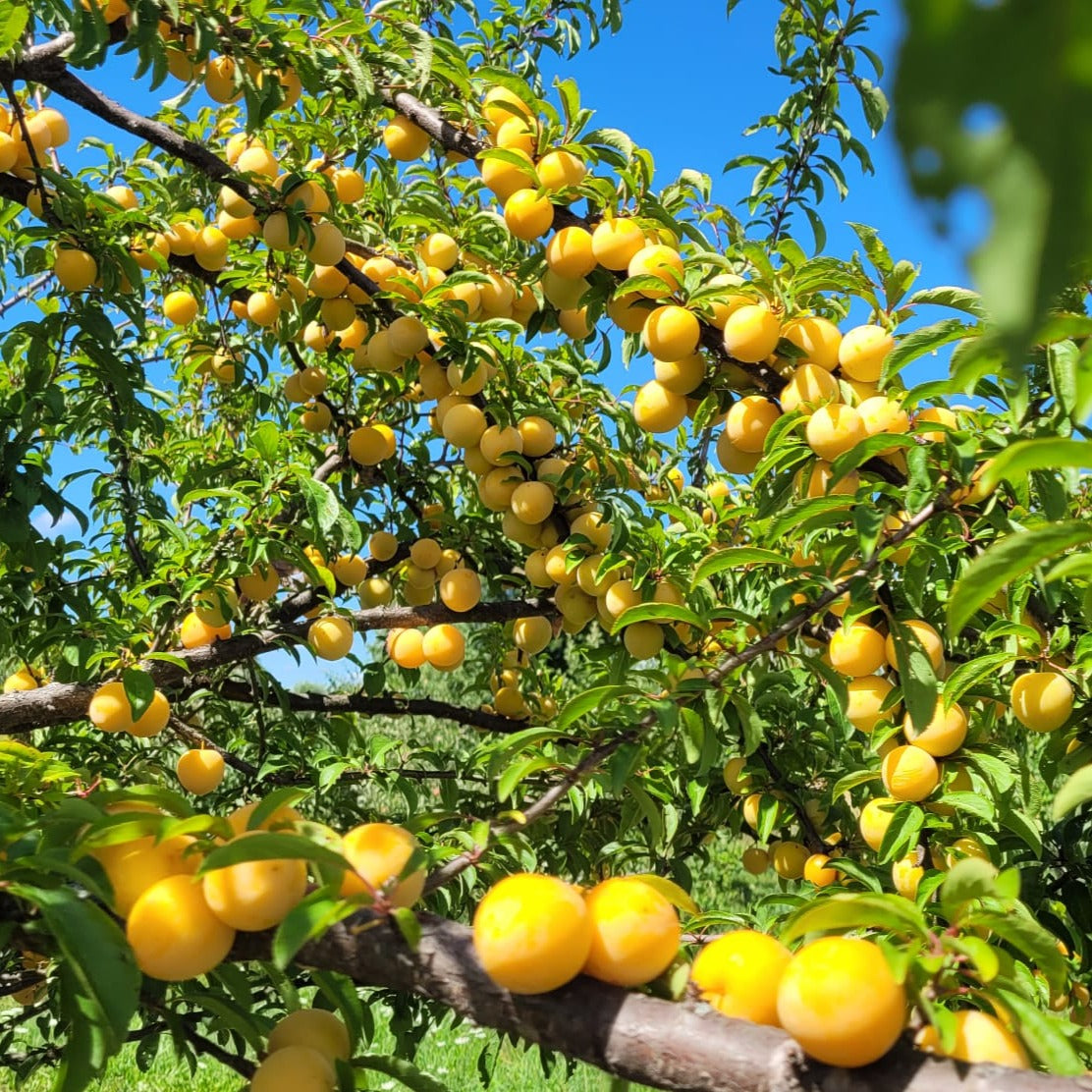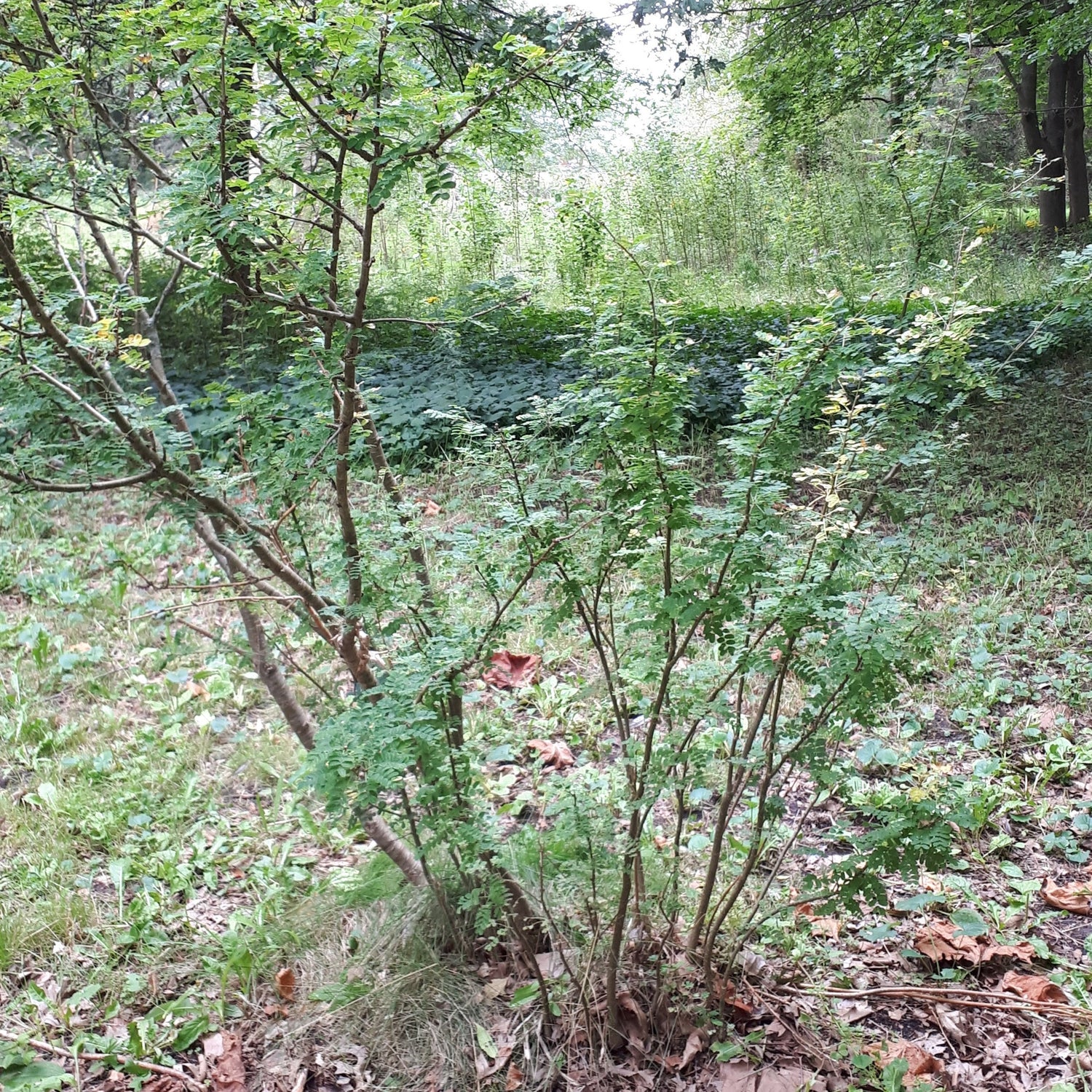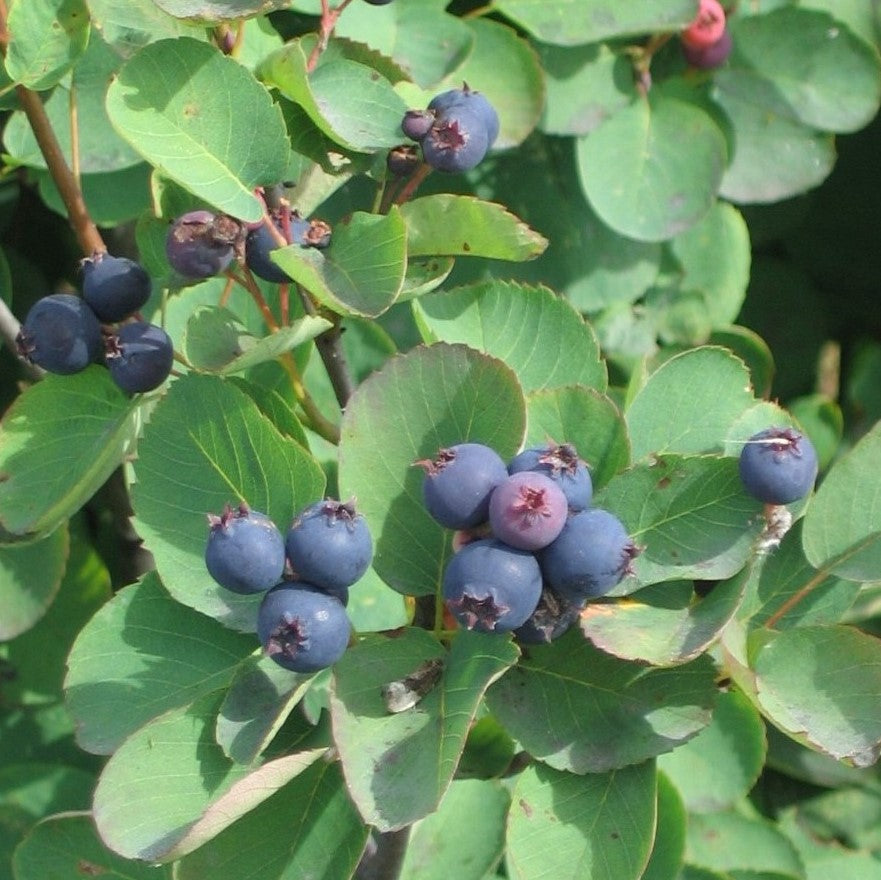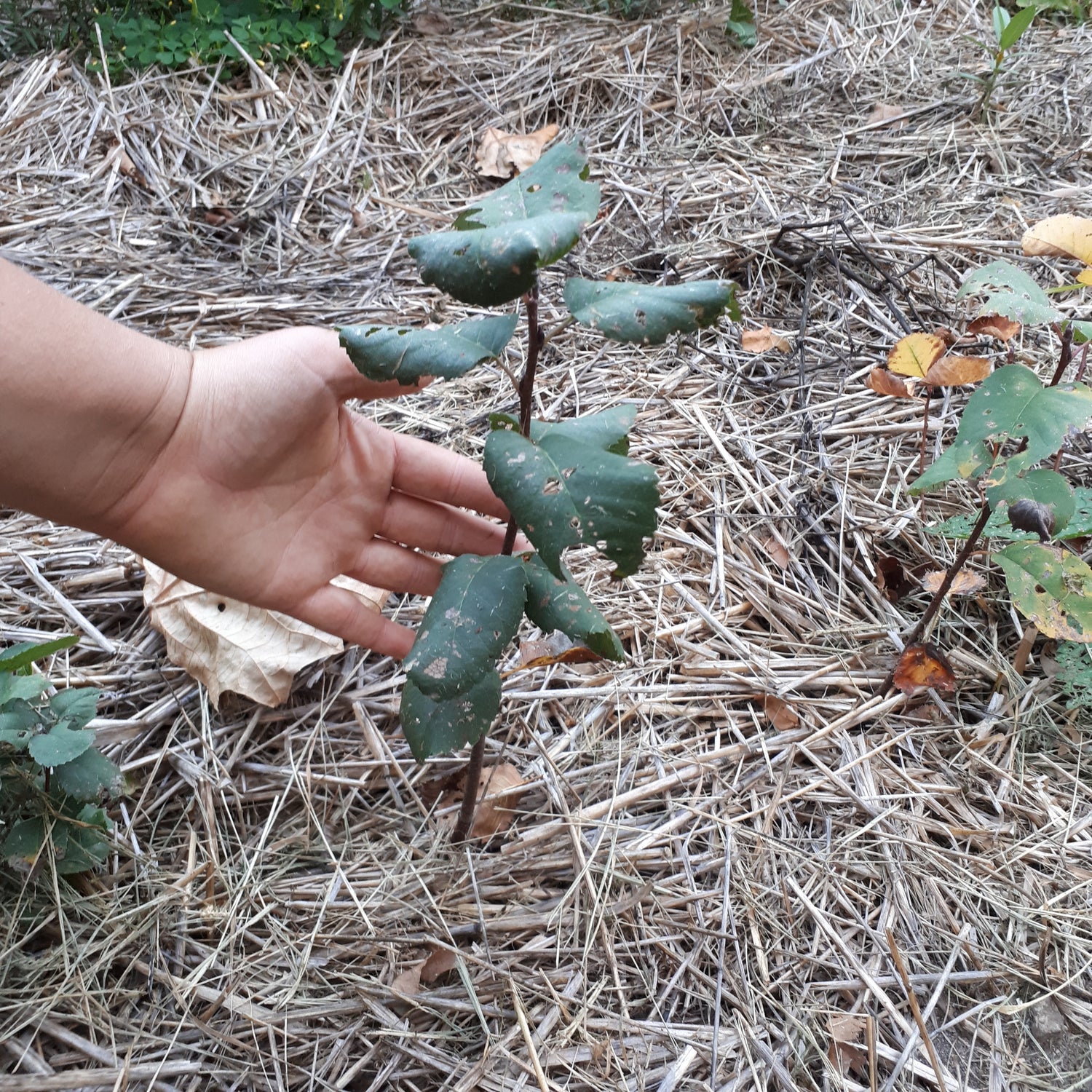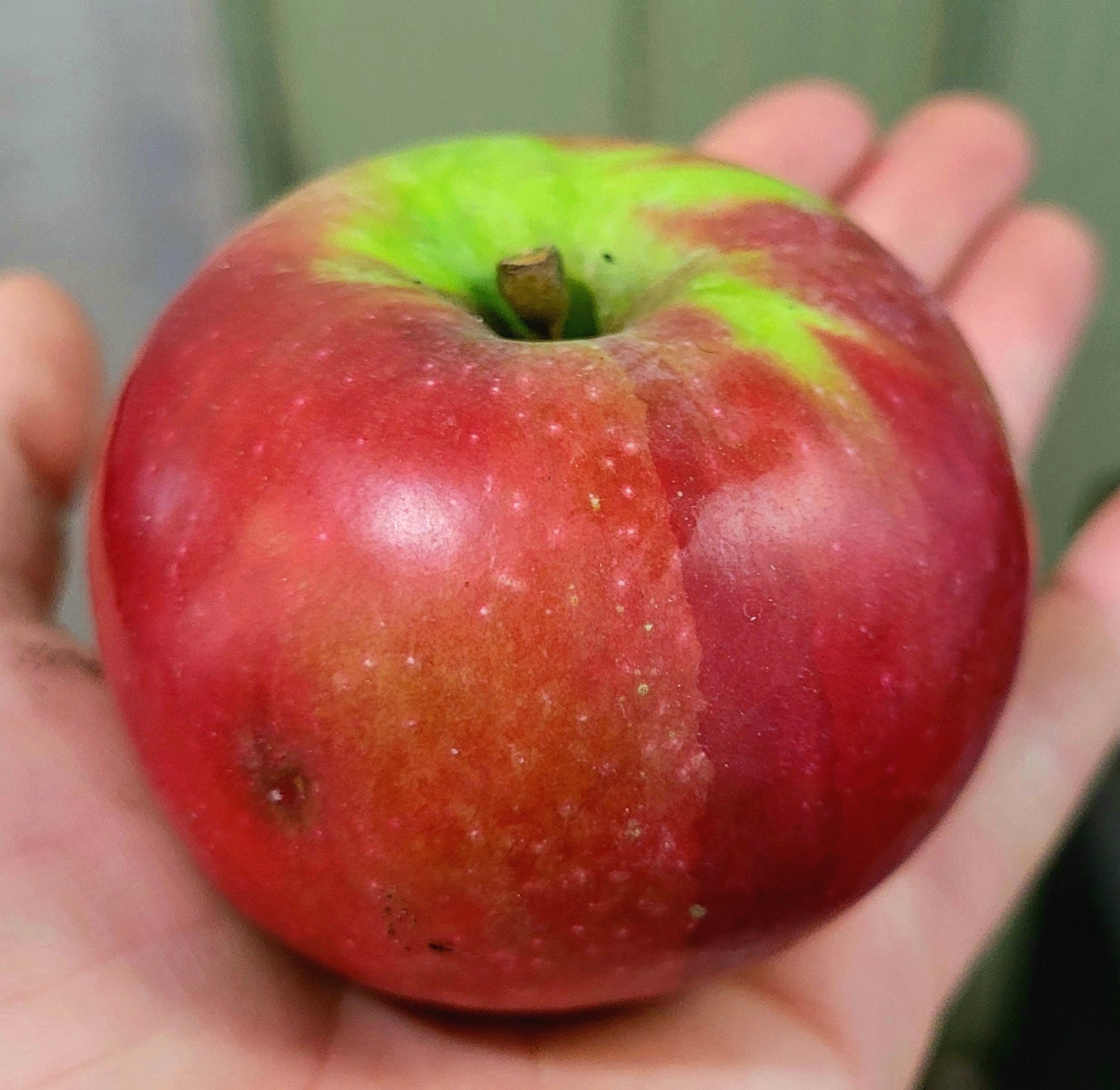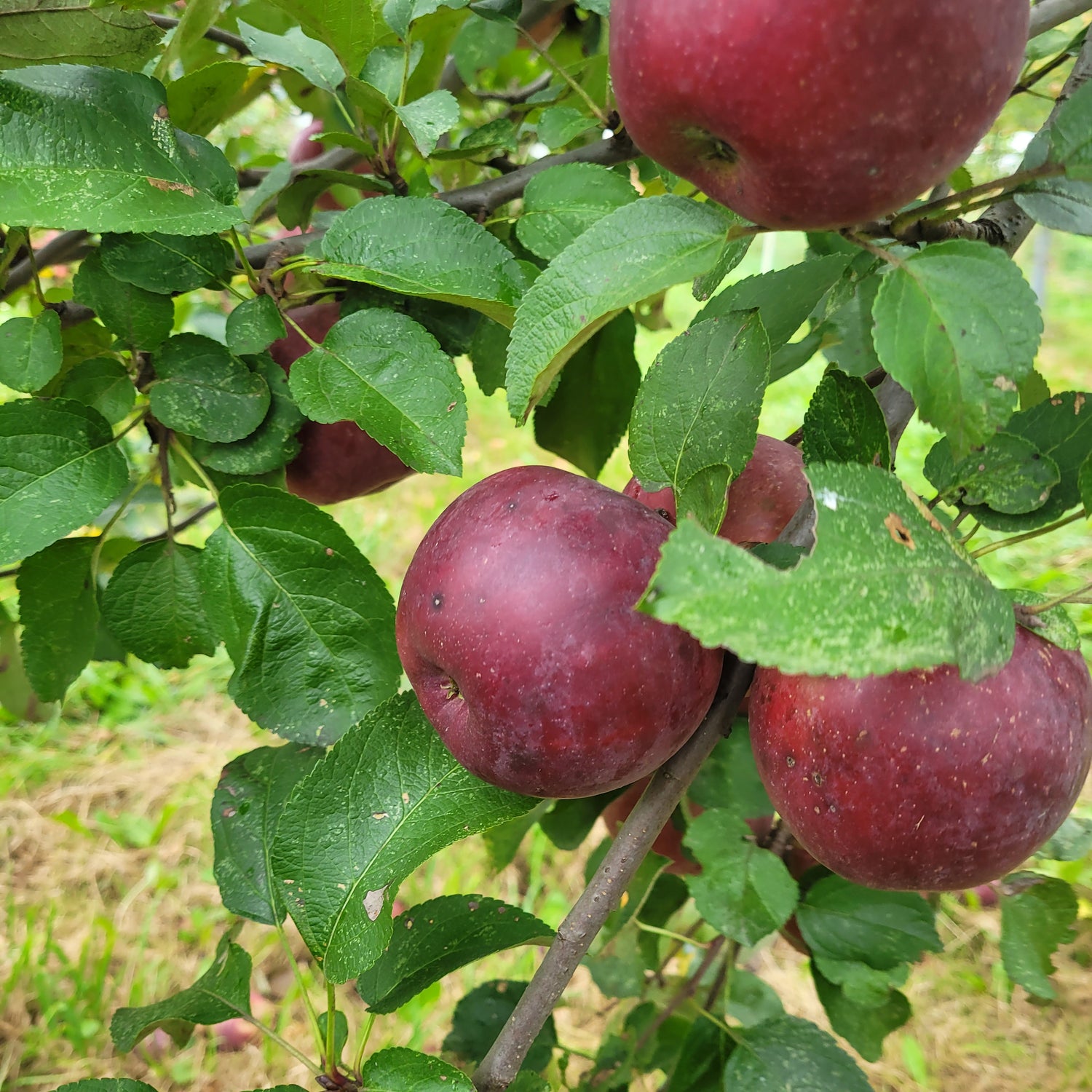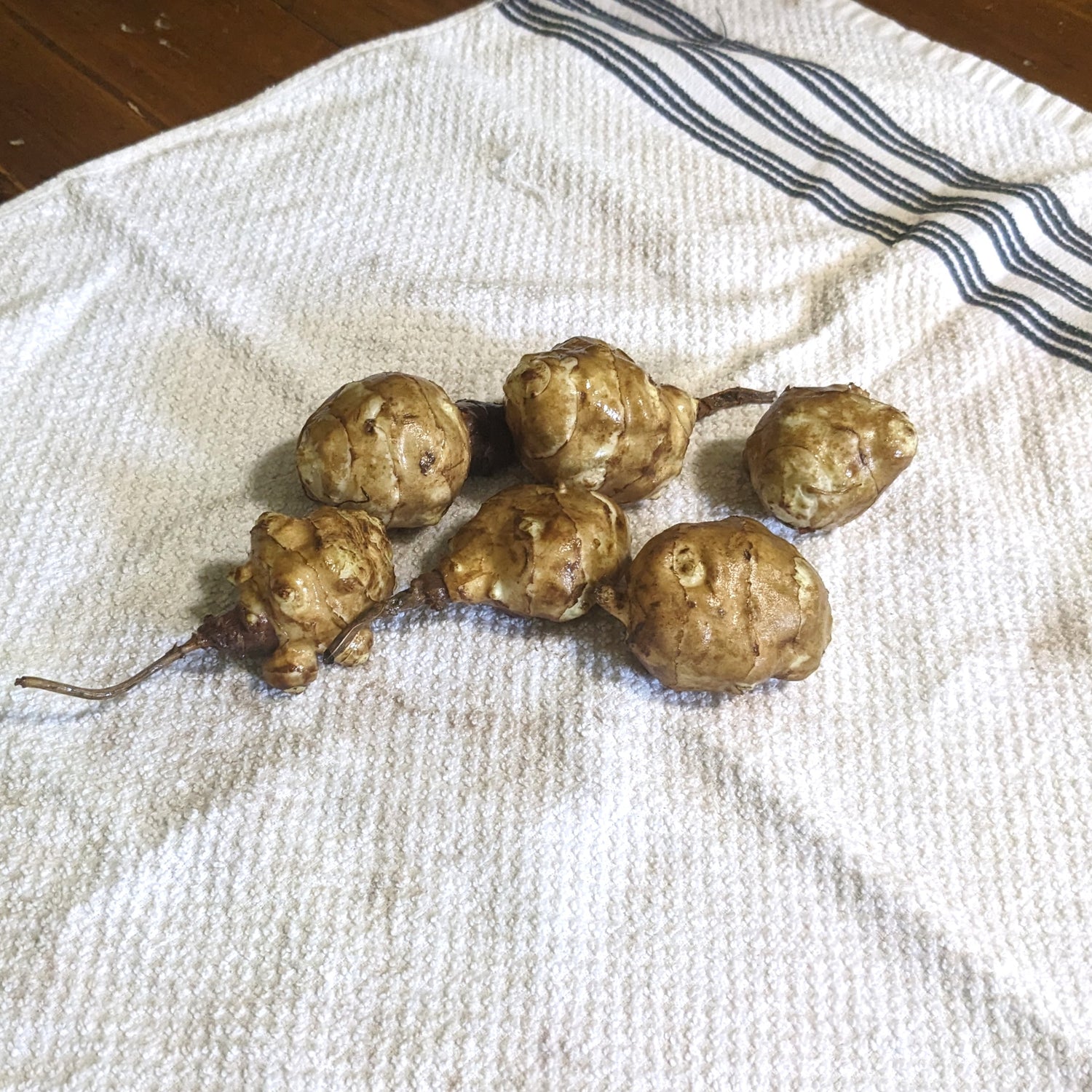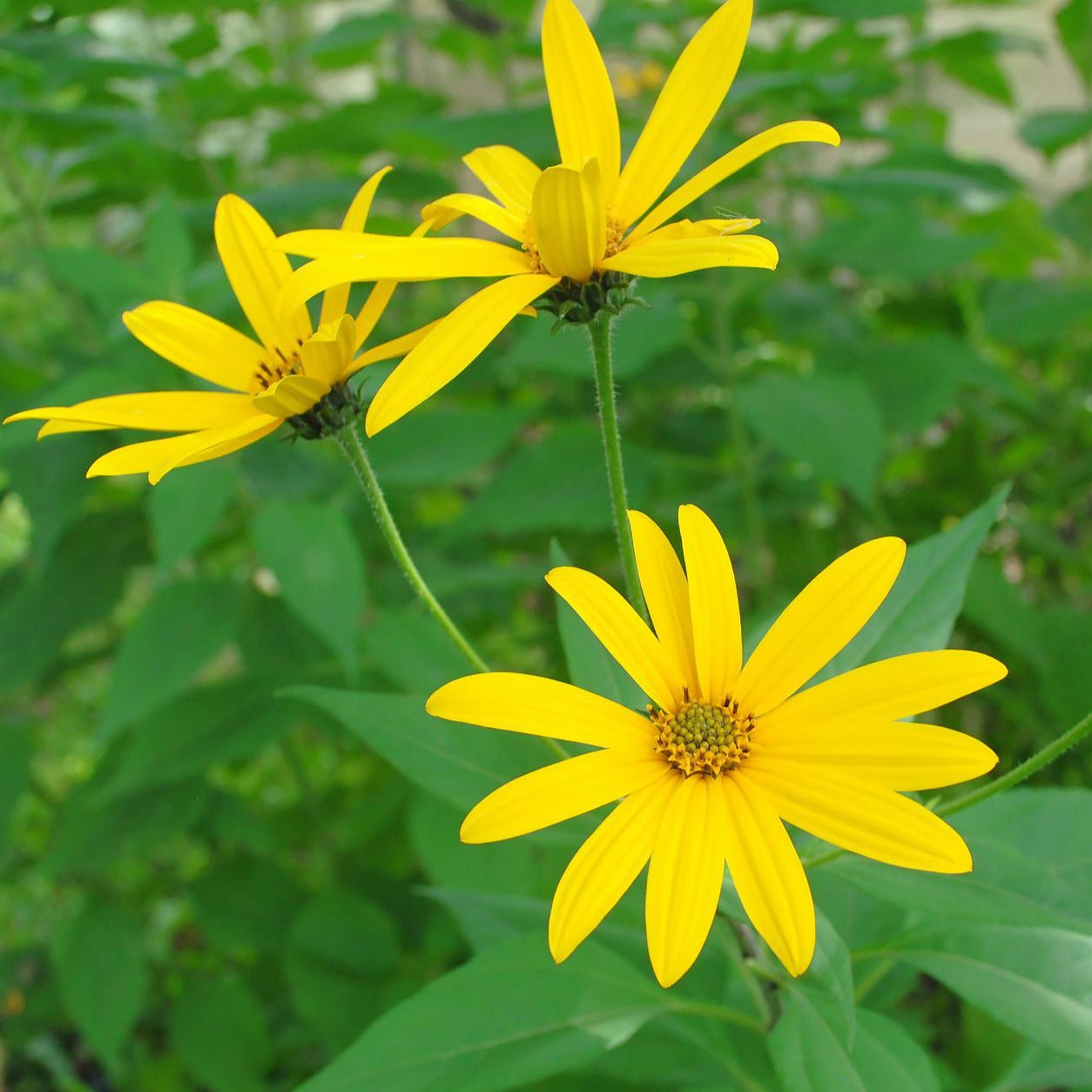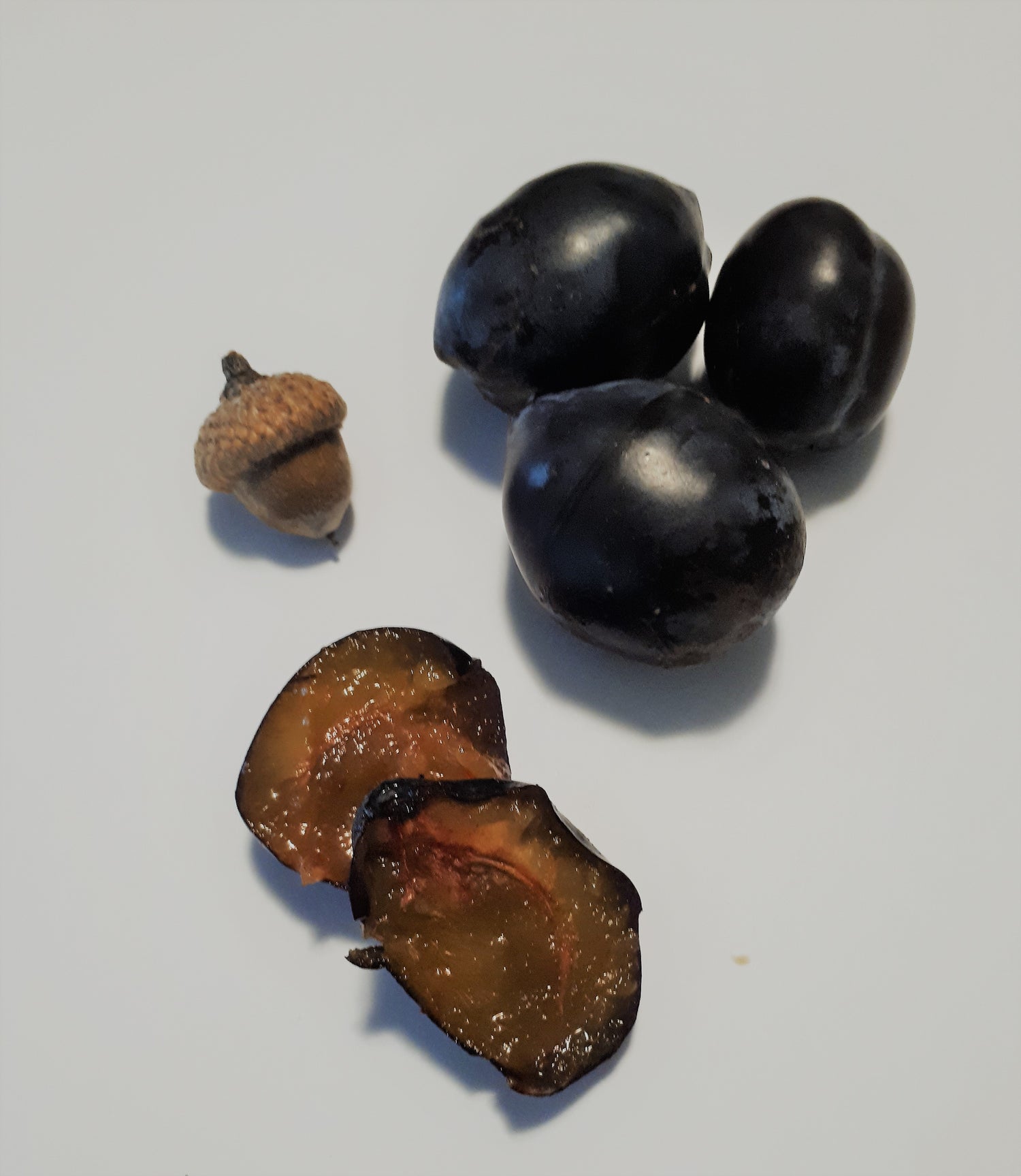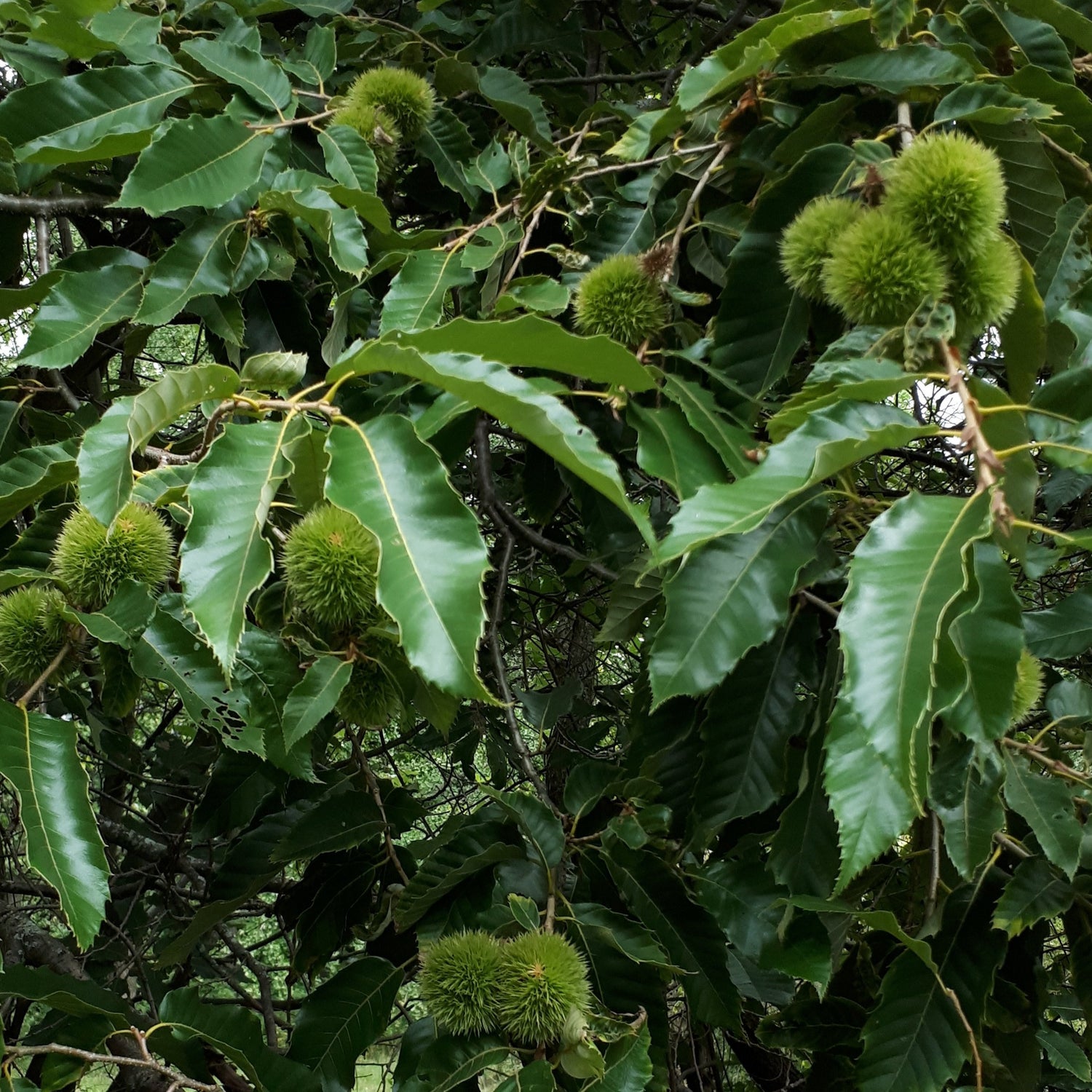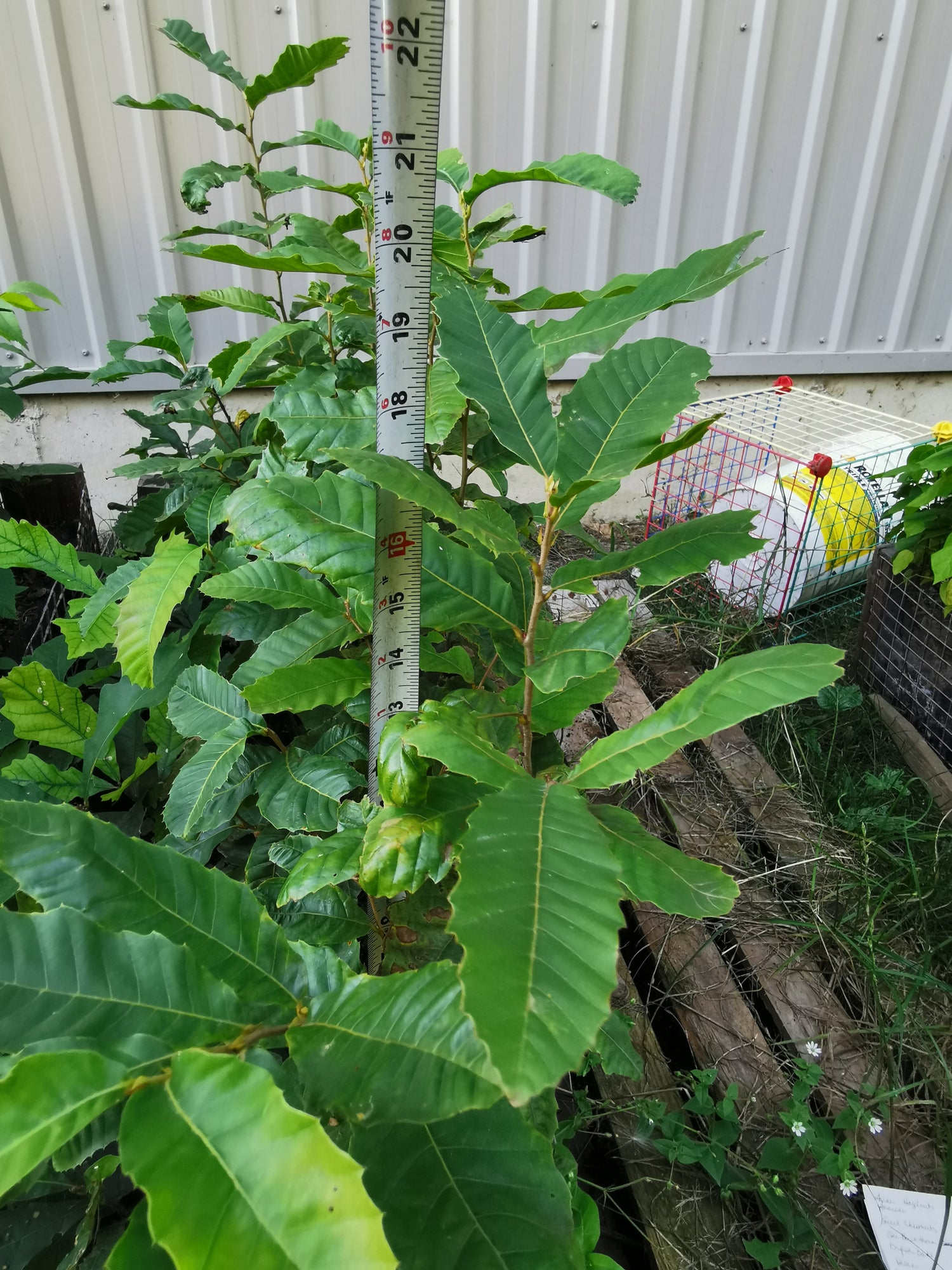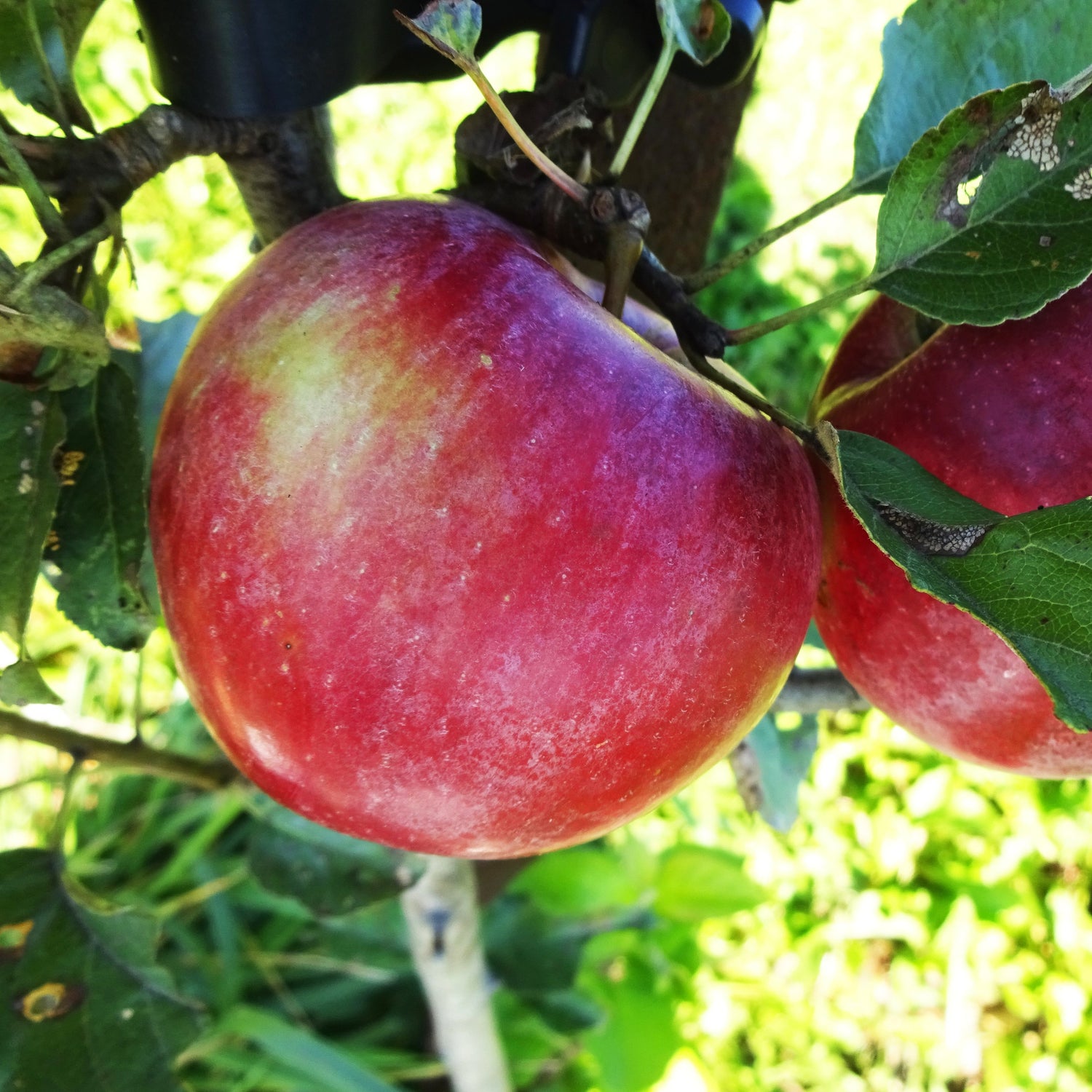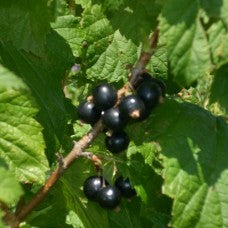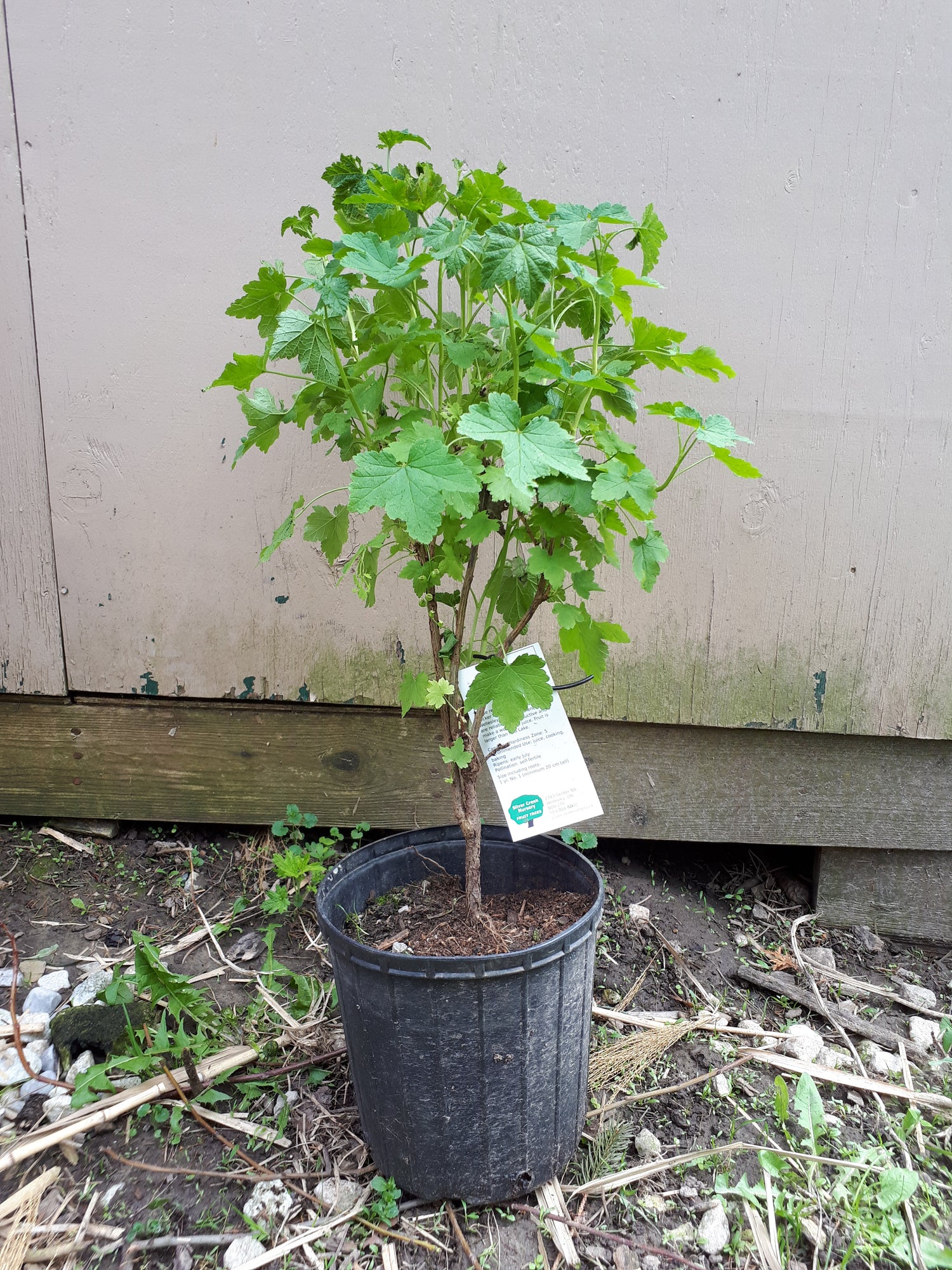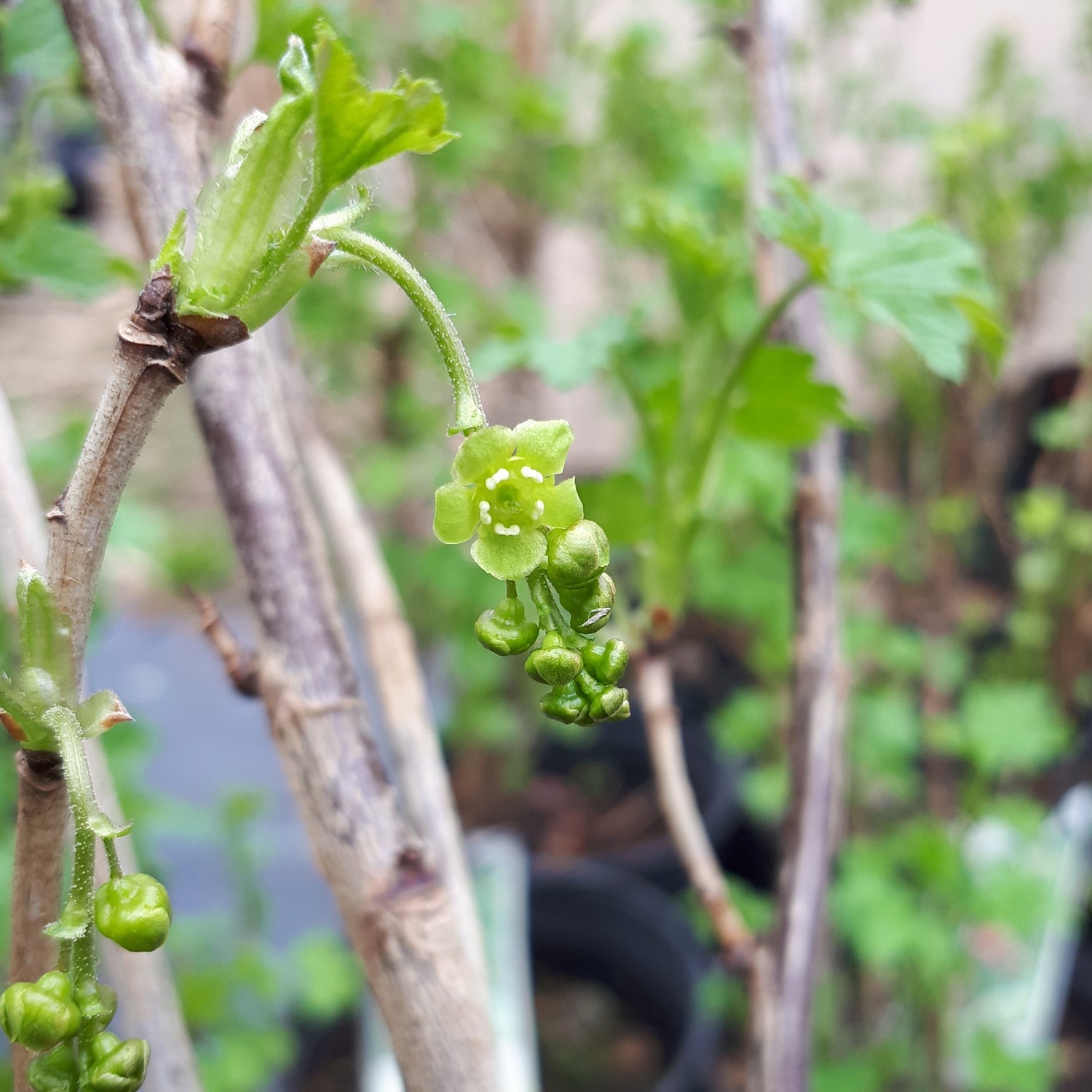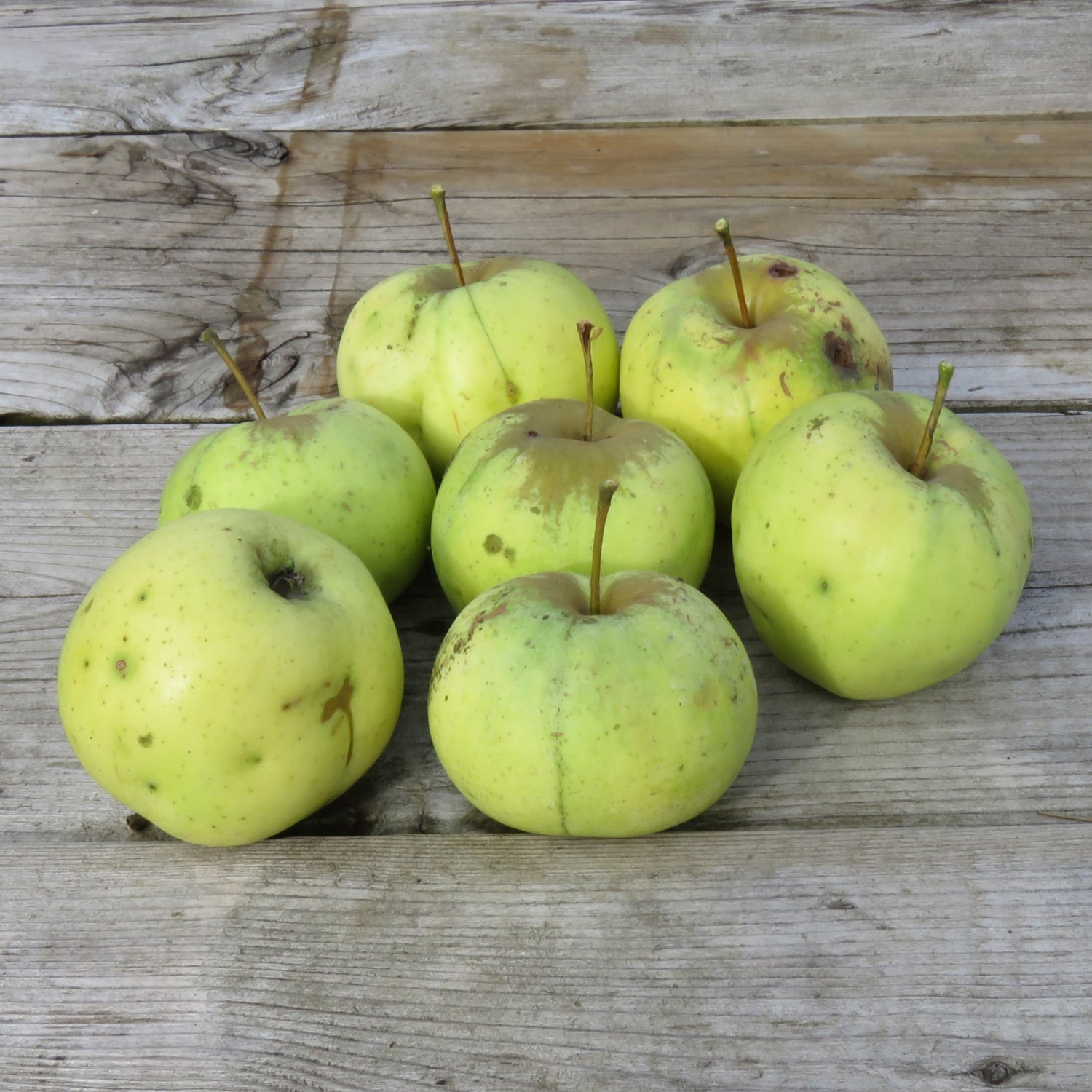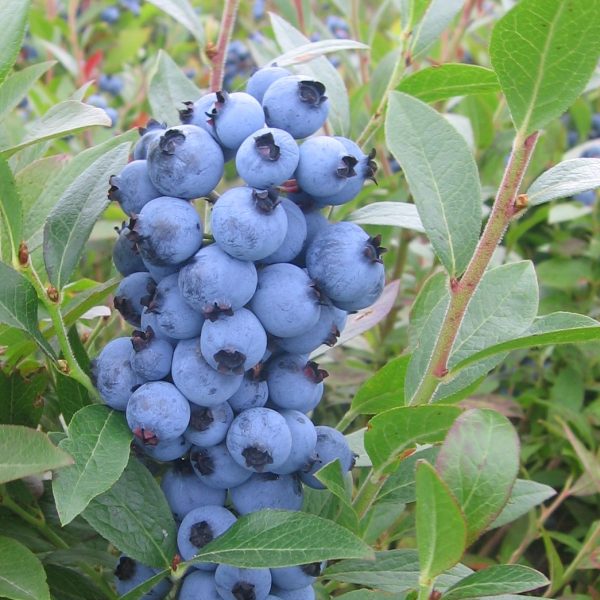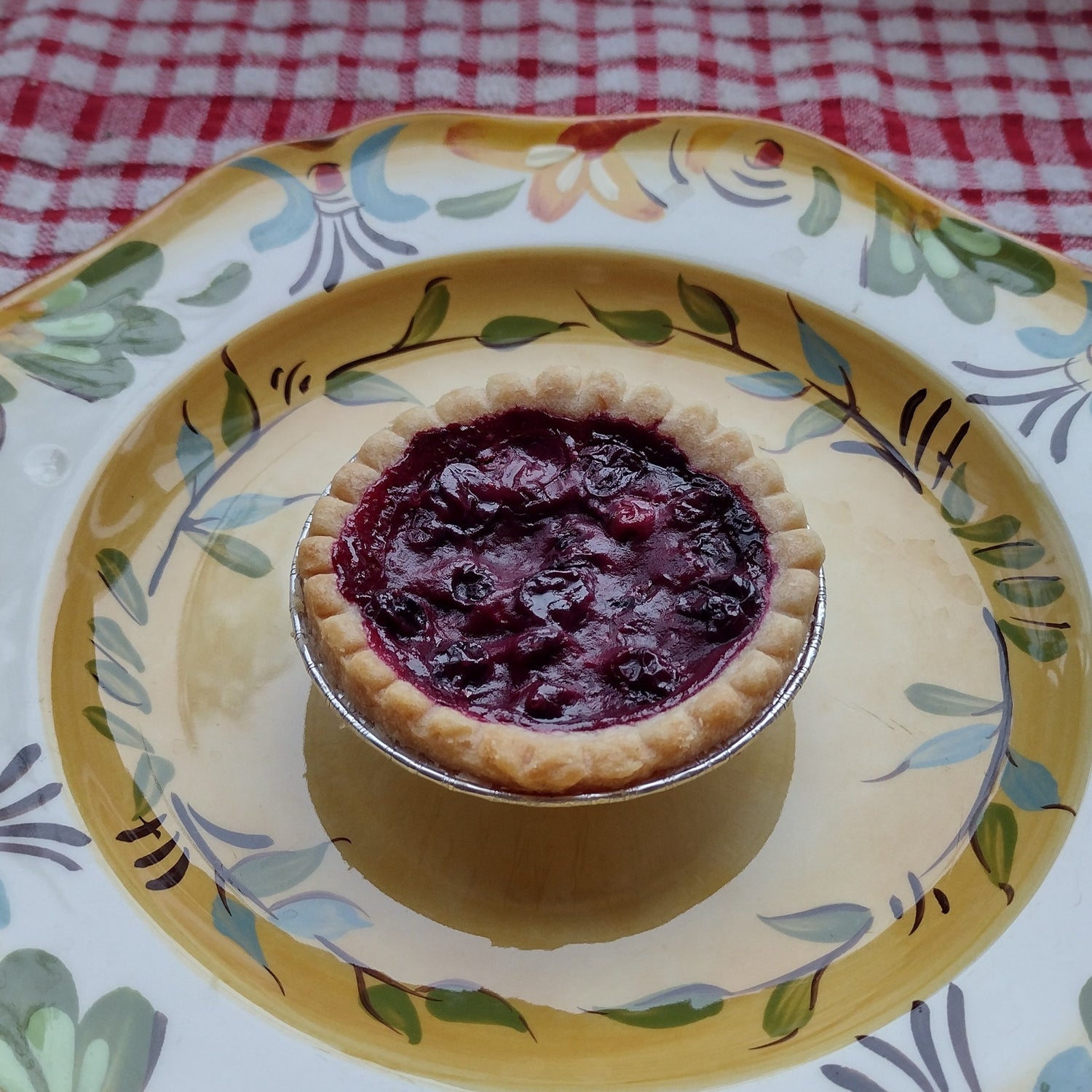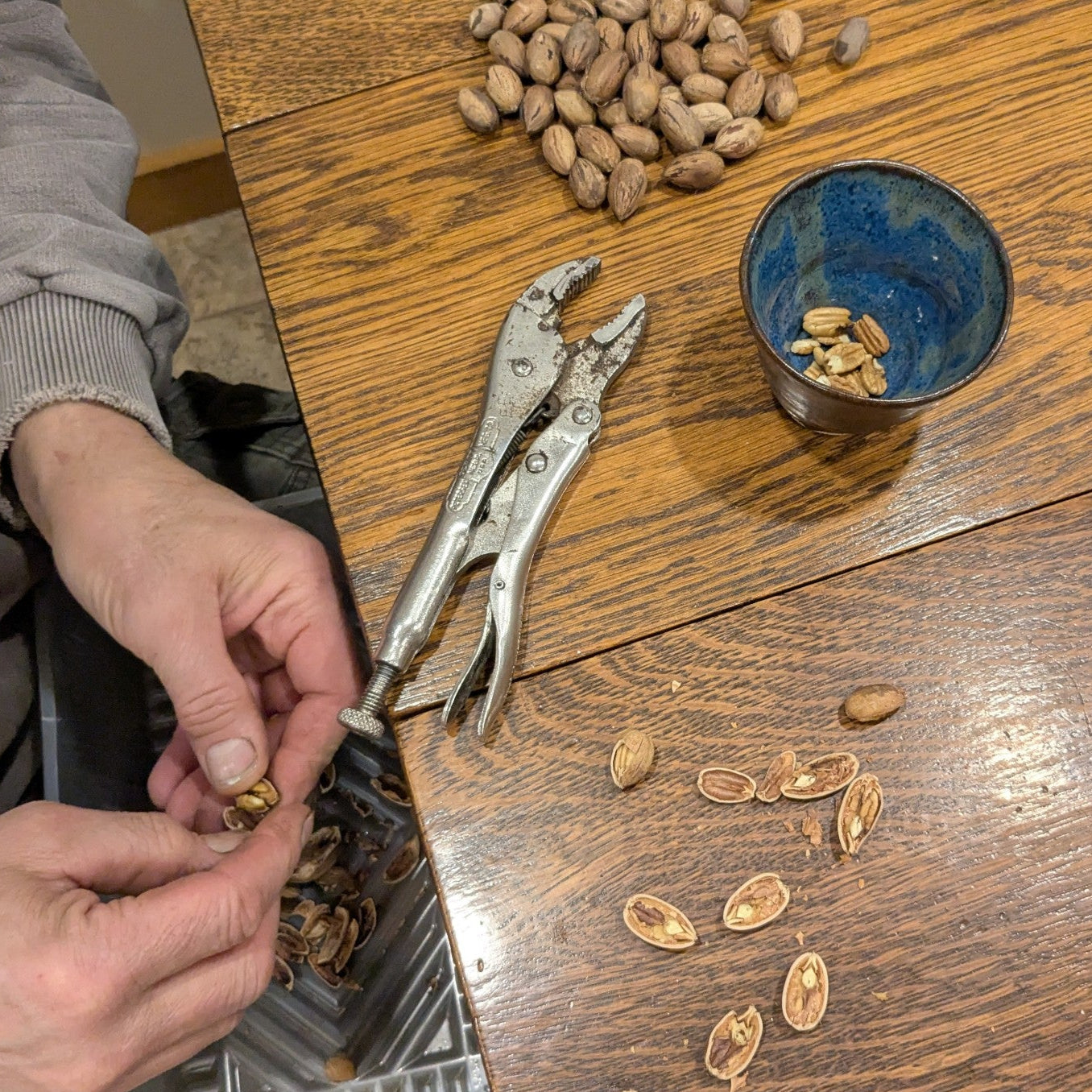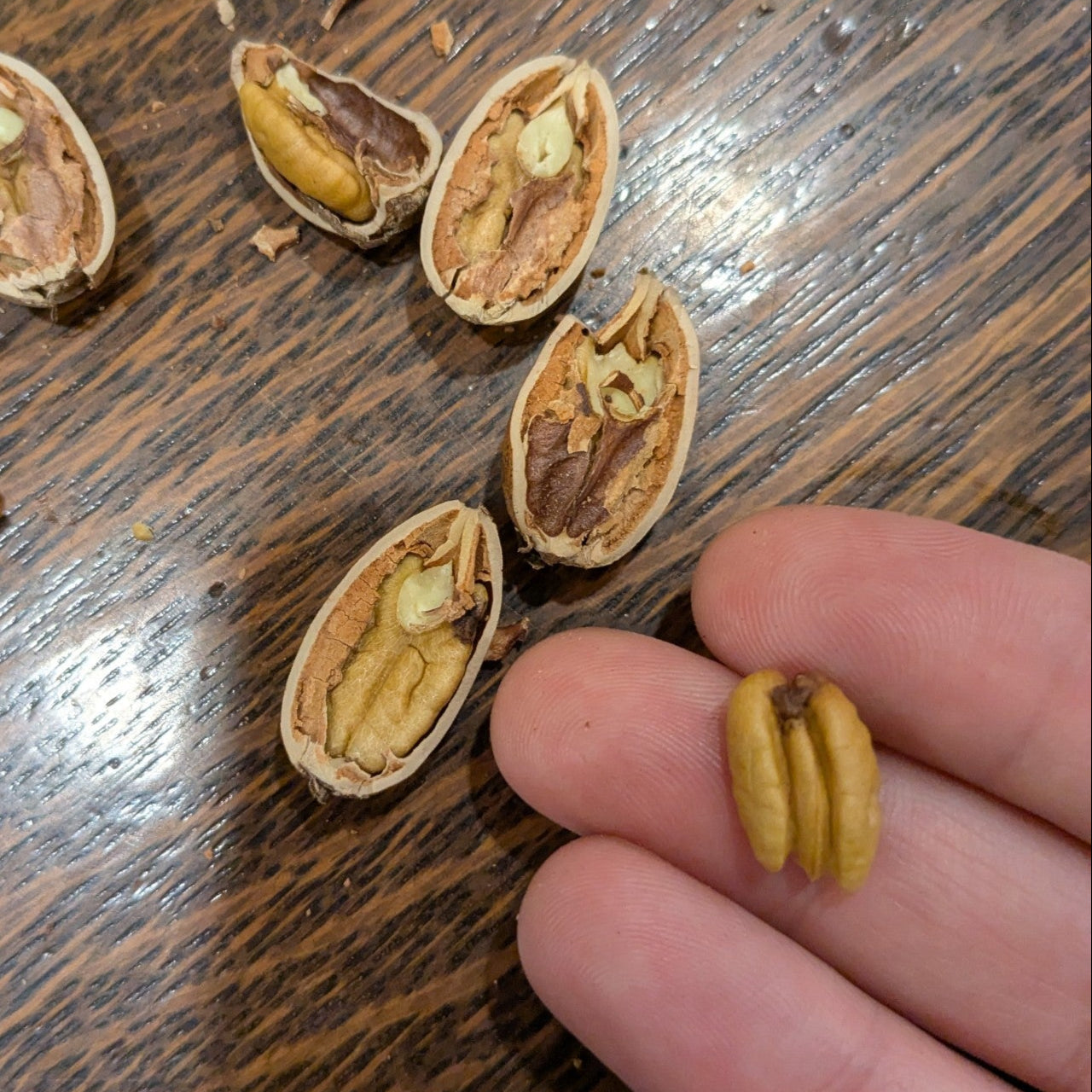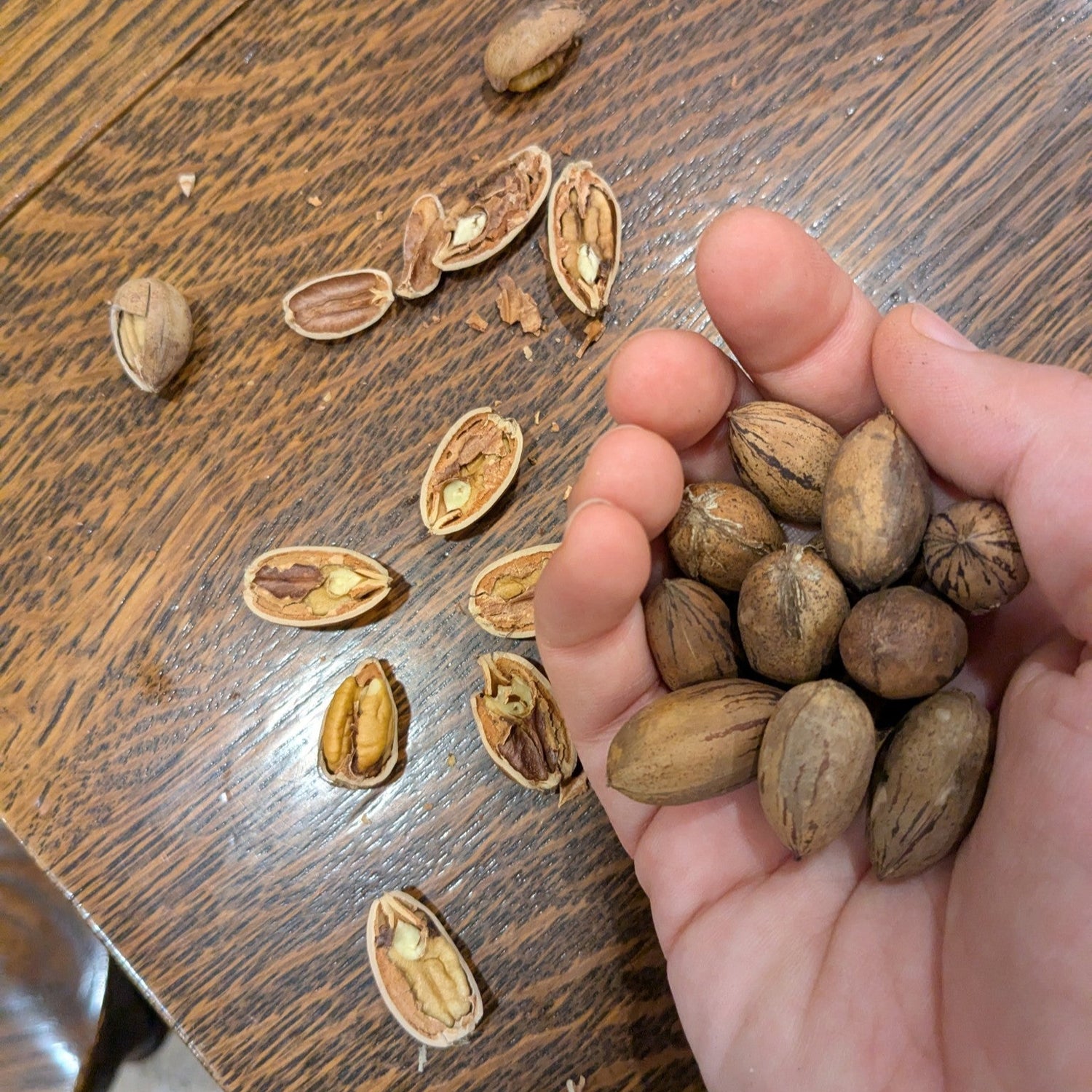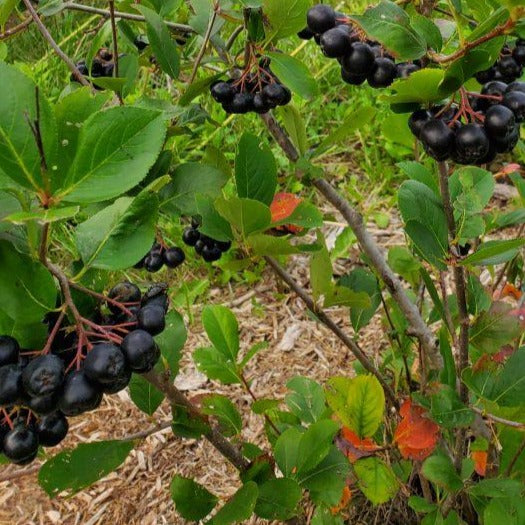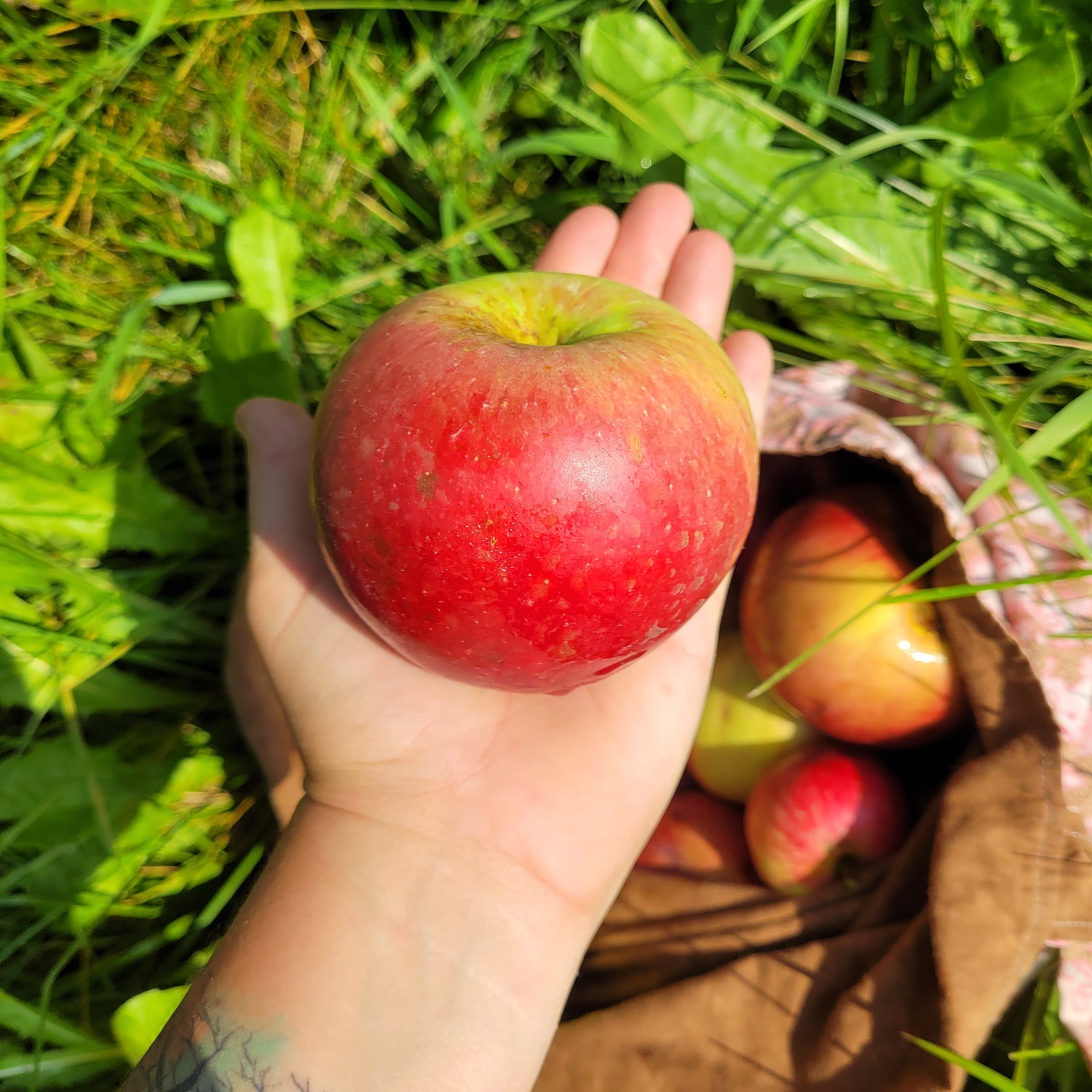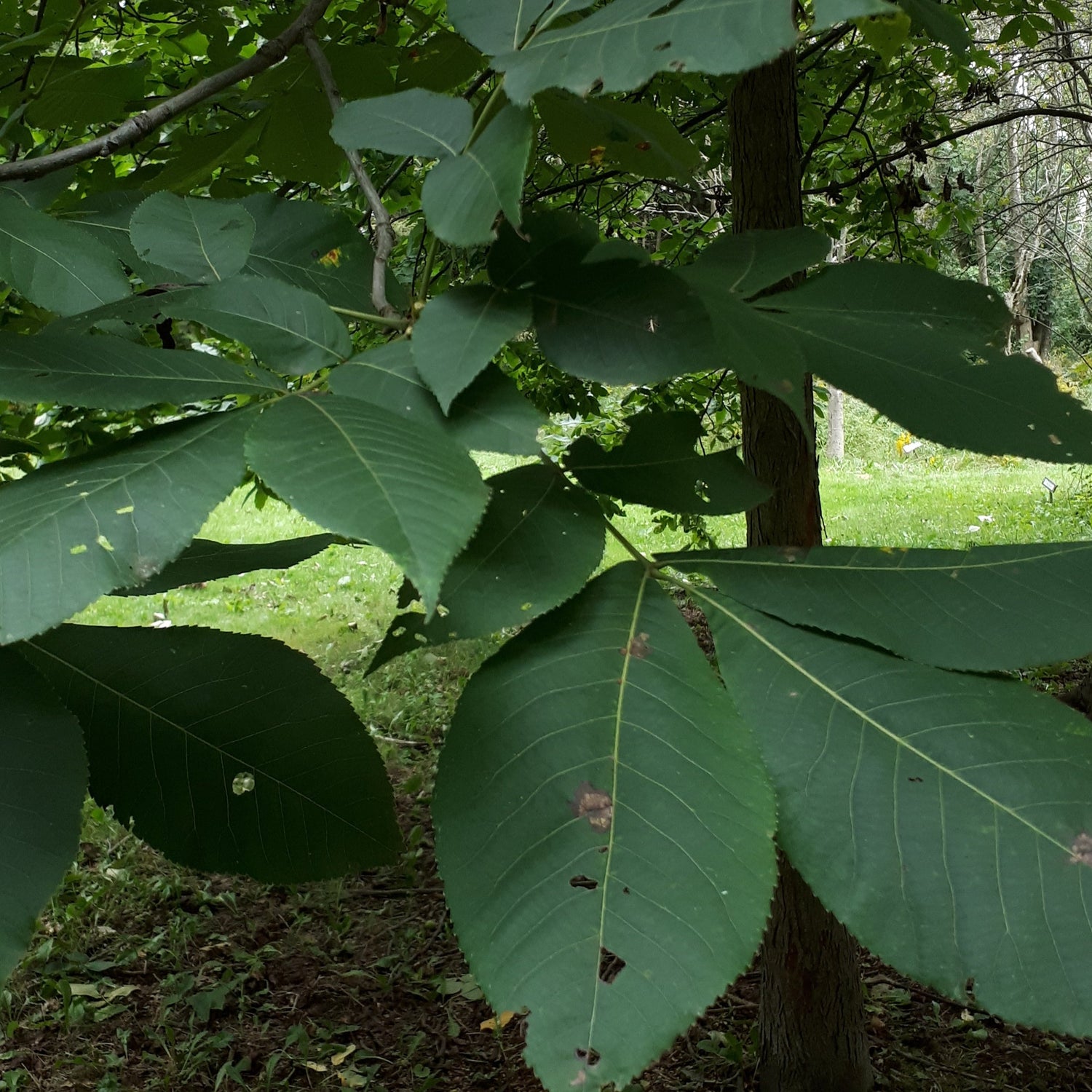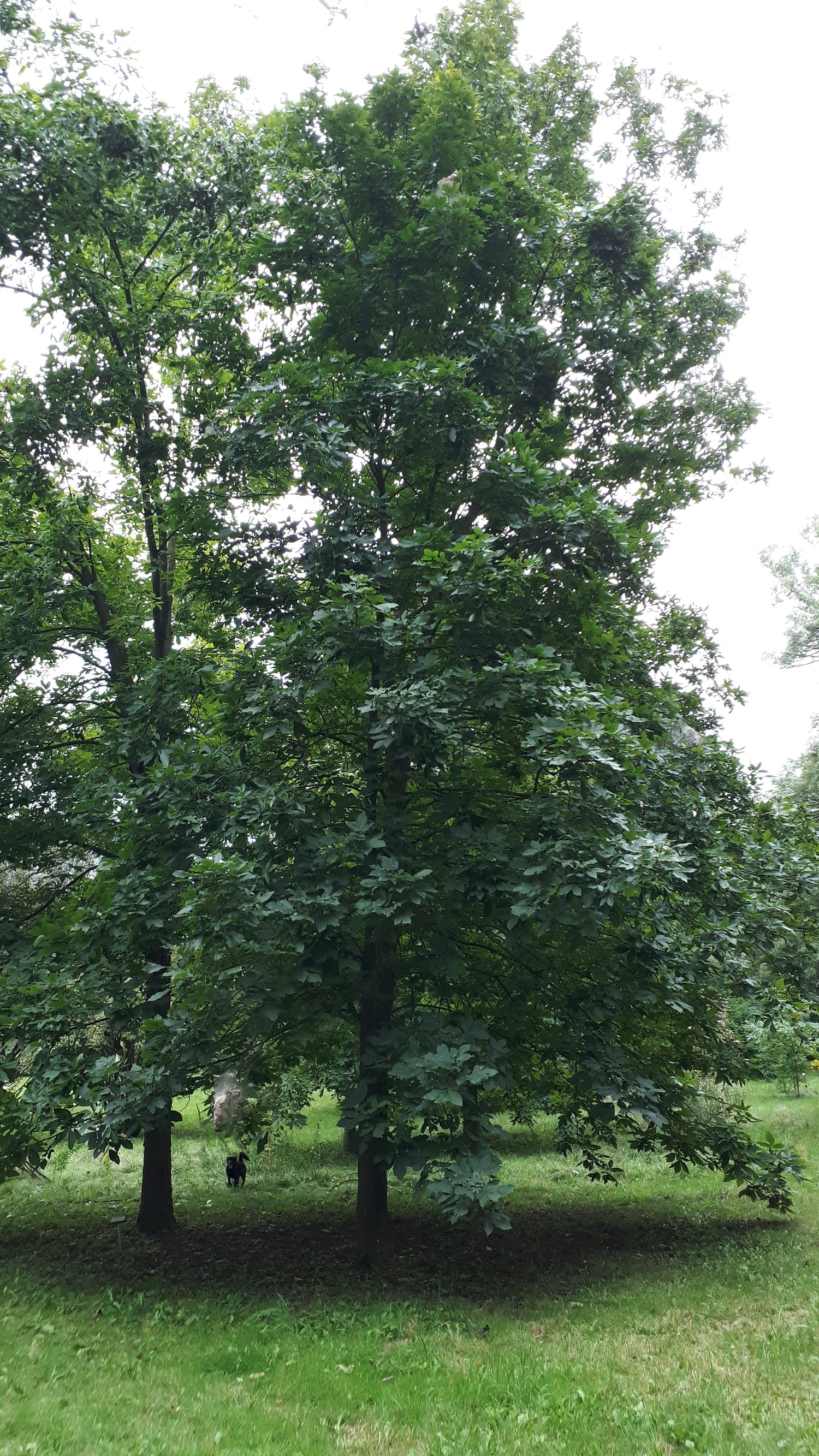Baking & Cooking Favourites
Sort by:
312 products
312 products
Species: Prunus sp
History: These seedlings are grown from Shiro plum seeds collected from our orchard and a Niagara orchard. Shiro plums (translated from Japanese as 'white') were developed in California and introduced in 1899.
Why We Grow It: Seedling fruit trees are a great way to add some diversity and mystery to your garden or orchard! The parent variety, Shiro, has yellow skin and flesh that is juicy and sweet.
Please Note: Since plums tend to stay true to type more than apples, these seedlings will likely bear a strong resemblance to their parent variety. However, any specific information listed on this page should be taken with a grain of salt as there may be some variation from the parent tree.
History: Shizuka (translated as "quiet" or "calm") was created at the Aomori Apple Experiment Station in Japan in the 1930s. It is a cross between Golden Delicious and Indo, the same parentage as its sister apple Mutsu.
Why We Grow It: Although it resembles Mutsu with its large yellow-green fruit, sometimes featuring a reddish-orange blush, Shizuka is sweeter and less acidic. This is an excellent fresh-eating apple for farm gate sales and it also keeps well. It is also great in salads due to its slow browning.
Species: Caragana arborescens
History: As the name implies, Siberian pea shrubs are native to Siberia but also parts of China, Mongolia, and Kazakhstan. They came to the US with Eurasian immigrants who used the pods as a source of food while traveling. It has been planted ornamentally and as bonsai, and can be used as erosion control. It is also unfortunately invasive in some parts of the US.
Why We Grow It: A classic permaculture plant! Siberian pea shrubs are nitrogen fixing, very hardy, disease and drought resistant, and, above all, edible. The flowers and young pods can be eaten fresh while the older pods are cooked. The plants are also attractive to pollinators.
Species: Shepherdia argentea
History: Silver Buffaloberries are native to the southern parts of the prairies, parts of the northern US with scattered populations further south. It is an important source of food and habitat for many species including Saskatchewan's provincial bird the sharp-trailed grouse. It is traditionally used by indigenous peoples in its range as food, seasoning, medicine, dyes, and in coming-of-age ceremonies for girls.
Why We Grow It: Silver Buffaloberries are an excellent addition to native gardens, food forests, and hedgerows! They are tolerant of a wide array of conditions and are also nitrogen-fixing. These shrubs are some of the first to produce flowers each spring, making them good resource for pollinators. The berries, which are often red but may be orange or yellow, are a good source of food for birds later in the season. The edible berries are on the bitter/tart side but are much more enjoyable when made into jams, jellies, and pies! Just be mindful these shrubs are thorny and will spread over time.
History: Skeena was developed at the Summerland Research and Development Centre in British Columbia in 1976 as part of an initiative to create a high quality cherry that ripens later in the season than other varieties. It is a cross between several self-pollinating varieties and was introduced in 2000.
Why We Grow It: These dark red cherries are often considered an improvement over Lapins with their larger size, good firmness, and general ease of harvest due to the spreading way the tree grows. The flavour is sweet with a touch of acidity. The tree itself grows vigorously and tends to start bearing fruit at a young age.
History: In the 1830s in Lancaster County, Pennsylvania, a seedling apple tree grew beside the smokehouse of William Gibbons. Perhaps it sprang from a core that some one had tossed there while they tended the fire. Who knows? What we do know is that the aptly named Smokehouse was commonly grown in the area until its popularity waned as sweeter apple varieties appeared on the market. Still, this variety has stood the test of time due to its great flavour.
Why We Grow It: Traditionally Smokehouse apples are picked a little early and used for baking, but if they're allowed to ripen fully on the tree, some people have described the balanced flavour as being “like drinking fresh-pressed cider!”.
Species: Amelanchier alnifolia (aka Western Serviceberry)
History: Smokey (sometimes spelled Smoky) likely originated in Alberta. This productive variety was once the main cultivar grown in Canada commercially.
Why We Grow It: Smokey saskatoon berries are optimal for the fresh eating market with a mild sweet flavour. These berries are a great substitute for blueberries. Smokey is one of the best yielding varieties, and grows up to 12 feet tall. Saskatoons by nature are slow growing, and while they will bear fruit in 1-3 years, it can take up to 15 years for a full crop.
Photo by Cindy Malette from Burst
History: Snow, aka Fameuse, apples originated near Lake Champlain in Quebec some time before the 1730s. The exact origin is unclear but this variety is thought to have originated from a seedling or cutting brought from France. From about 1750-1850, this was one of the most commonly grown apples in Quebec until the orchards were almost wiped out in the latter half of the 19th century by disease and failed to regain their popularity. However, these lovely apples may still be with us in their own way as they are one of the potential parents of McIntosh.
Why We Grow It: It is easy to see why Snow apples were once so popular. These apples have a lovely deep red skin with pure white flesh with a sweet strawberry flavour. These trees are also quite cold hardy and produce heavy crops.
History: Spartan apples are a Canadian variety that was developed at the Pacific Agri-Food Research Centre in Summerland, BC in 1936 by Dr. R.C. Palmer. Of particular interest is the fact that Spartan apples are the first apple variety created by a formal scientific breeding program. They have been popular in North America ever since and are even commonly found in gardens in the UK.
Why We Grow It: This variety is known for its sweet/acid flavour and pleasant crunch, especially when eaten fresh off the tree. They tend to soften rather quickly after they are picked but luckily the fruit hangs on the tree 2-3 weeks after its ripe which helps to extend the optimal time to enjoy this variety. Spartan apples are also known for being relatively easy to grow, having decent disease resistance, heavy crops, and an ability to keep all winter.
Species: Lindera benzoin
History: Spicebush is native to eastern North America, although in Canada it can only be found in Ontario. It has been used medicinally by several indigenous peoples and early land surveyors used it to find good agricultural land due to its propensity to grow in good soil. It remains a popular ornamental plant along with its uses for spices and teas. Spicebush is also the only host plant for the spicebush swallowtail.
Why We Grow It: If you want to source your own spices locally, try this aromatic, native shrub! The leaves and berries can be used as substitutes for cinnamon, nutmeg, and allspice. It is attractive to butterflies and the early bloom time means it is a good source of pollen in the spring. The shrub is also quite pretty in autumn when its leaves turn a bright yellow.
History: The St. Lawrence apple was discovered in the Montreal area as a seedling of a Snow apple, the most popular variety in Quebec at the time. By 1835, these apples were commonly grown in the area where they were popular for fresh eating and cooking but have since faded into obscurity.
Why We Grow It: Although less popular now, these apples are still good for eating and baking. The boldly striped red skin also makes the fruit very attractive. The tree bears good crops each year and is relatively hardy.
Species: Helianthus tuberosus, Sunchokes are also known as Jerusalem Artichokes or J Chokes
History: Stampede apparently originated on a reserve in northern Ontario where indigenous peoples had been cross-breeding the earliest flowering sunchokes they could find. They succeeded with Stampede which is an early flowering and ripening variety. In 1978, only two tubers were sent to Johnny's Selected Seeds in Maine, producing enough tubers by the end of the year that the nursery was able to introduce the new variety commercially in 1979.
Why We Grow It: Stampede is an extremely productive variety and produces relatively large, if somewhat knobby, white tubers. Like other sunchokes, Stampede can be prepared and eaten in a variety of ways, similar to the many ways you can use a potato! The early flowering and ripening time of this variety is great for anyone with a limited growing season.
History: Stanley plum was developed in Geneva, New York by Cornell University and released in 1962.
Why We Grow It: This freestone European plum has deep purple skin and meaty, golden flesh, the standard for prunes. It has a sweet juicy flavour and is great for fresh eating, canning, and drying. The tree produces heavy, reliable crops.
Why We Grow It: It is hard to turn down an apple that sounds as wonderful as Sundance! It is crisp and juicy with a spicy, citric flavour. Along with being great for fresh eating, the fruit also holds its shape well when baked. As an added bonus, this variety is resistant to many common apple diseases and stores quite well so you'll have plenty of high quality apples to easily last you through the winter.
Species: Castanea dentata x mollissima
History: These seedlings are a cross between Chinese chestnuts and American chestnuts grown from seed from Grimo Nut Nursery. As a hybrid of Chinese and American chestnuts, these seedlings have blight resistance along with good cold hardiness.
Why We Grow It: This tree has incredible potential as a truly sustainable food source for humans. High in vitamins and starch, the nuts can be used to make a flour food staple, or pressed for oil to be made into bio fuel. For more inspiration and ideas in growing sweet chestnuts as a crop, we recommend the book Restoration Agriculture: Real-World Permaculture for Farmers by Mark Shepard.
History: Sweet Sixteen was developed by the University of Minnesota and introduced in 1977. It is one of nearly thirty varieties released by the university since its breeding program began in 1888.
Why We Grow It: Some apples taste better when grown in colder climates, and Sweet Sixteen is one of them. For a fresh-eating apple, this is a favourite. Sweet Sixteen provides that crisp first bite that so many people love in an apple, and the pure white flesh will not disappoint for flavour with a very unique, distinct honeyed flavour. Its cold-hardiness and general disease-resistance (tolerant of scab and cedar rust) make it winner for the grower too.
Species: Gleditsia triacanthos
History: Thanks to its ability to tolerate a host of adverse conditions that would hinder or kill other trees, Honey Locusts have been cultivated for us as ornamental, urban trees. As a result, several thornless varieties have been developed including the mother tree for these seedlings.
Why We Grow It: Honey Locust has many benefits for permaculture and now growers do not need to worry about popping tires with thorns thanks to these thornless trees - though they are seedling so some may develop thorns though most will not; these can be top grafted with a thornless type if needed.. Reaching 30 meters tall, this native nitrogen fixing tree benefits many including bees, wildlife, and even humans: we can use the sweet (honey flavoured) pulp inside their pods in baking, tea or for brewing beer. The durable, rot-resistant wood has a variety of uses.
History: Thunderchild is a crabapple that was developed by Percy Wright, a prairie plant breeder in Saskatoon, Saskatchewan. Although it is unknown when exactly Thunderchild was created, it likely came about in the 1900s and can still be seen as a common ornamental tree in the area.
Why We Grow It: Thunderchild makes for a lovely ornamental tree with a profusion of pink blossoms in the spring and deep red foliage. The tiny dark red fruits it produces can be used in cider blends and to make jellies with a gorgeous orange hue. The tree is quite cold hardy and generally disease resistant.
Species: Ribes nigrum
History: Titania black currant was developed by Pal Tamas in Sweden. It was bred as a cross between the varieties Consort, Kayaanin Musta, and Altaskaya Dessertnaya in 1969 and chosen for further evaluation in 1974. Since its release it has become one of the most popular currants in North America.
Why We Grow It: It is easy to see why Titania has become so popular. It produces large, juicy berries with a rich, mild flavour. It is also resistant to White Pine Blister Rust and mildew. The berries are great for a variety of uses, such as the black currant scones and black currant and blueberry tarts Steph made (see pictures)!
2025 Staff Favourite
Tolman Sweet Apples are Mouse's favourite this year! In their opinion Tolman Sweet apples are “a lovely green apple with a very unique sweetness! A must-try for anyone interested in exploring the full range of apple flavours!”
All Staff Favourites are 20% off. The Staff Favourite Discount cannot be combined with other quantity discounts.
History: Little is known about the origin of this heritage apple, but Tolman Sweet has been highly valued since its discovery. It is uncertain whether it came from Massachusetts or New York in the 18th or 19th century but it was first recorded in 1822. This hardy tree was used as a source of rootstock at one time.
Why We Grow It: Tolman Sweet is a great all-purpose apple. The fruit are medium-sized with yellow skin, and have a distinctly sweet, dry flesh. They are nice for fresh eating but can also be used in baking, drying, and pickling. Their unusually low acid content helps to reduce acidity in both sweet and hard cider.
Species: Vaccinium angustifolium
History: Top Hat lowbush blueberry was released by the Michigan State University Agricultural Experiment Station some time before the mid to late 1970s.
Why We Grow It: This variety produces small berries with a rich sweet-tart flavour. It is a popular pick for bonsai and container gardening. Blueberries are great for baking, for example Steph made some wonderful black currant and blueberry tarts that are pictured here!
Species: Rubus fruticosis
History: Triple Crown was bred in Beltsville, Maryland by the USDA in order to create a good thornless variety for commercial sale. It was released in 1998 and was named Triple Crown due to its three crowning qualities: good flavour, high yields, and vigour.
Why We Grow It: Triple Crown produces large, glossy berries that are sweet and tart. It bears fruit uniformly and the canes are thornless, making the berries very easy to pick. They are good for fresh eating and great for baking.
Species: Rubus idaeus
History: Tulameen was bred at the Pacific Agri-Food Research Centre in 1980 and released in 1990. It was selected for its disease resistance, long ripening period, large fruit, and excellent flavour and quality. The name likely comes from either the Tulameen River or the town of Tulameen in BC, although it also means 'red earth' in Nlakaʼpamuctsin.
Why We Grow It: Tulameen is a summer-bearing variety that is known for producing large crops of huge red raspberries that are very sweet! The exceptionally tall canes may require some trellising but have very few thorns which makes handling them much easier than other varieties.
Species: Carya illinoinensis
History: Pecan enthusiasts John Gordon and Gary Fernald, determined to get pecans to ripen regularly in Ontario, collected nuts and and grafting material from the earliest ripening pecan trees along the northern edge of their range in Iowa and Missouri. These were grown and tested at Grimo Nut Nursery and the best were chosen to form the Ultra Northern pecan strain.
Why We Grow It: Considering the amount of hard work that went into bringing these trees to Ontario, it's hard to turn down the ability to have a pecan tree in your own backyard. Like a regular pecan, the nuts can be used in a variety of ways for cooking and baking, such as the persimmon and pecan cookies Steph made (see pictures)!
Why We Grow It: It is easy to see why growers were so eager to overlook Viking's scab susceptibility, its flavour providing a sweet-tart taste with notes of rose and lychee. It is an excellent all-purpose apple that can be used for cooking, baking, sauce, and cider. Its great flavour and utility is matched by its attractive appearance, the large fruit featuring dark red skin bordering on maroon. However, it does bruise easily and brown quickly and only stores for about a month at most.
Species: Aronia melanocarpa
History: Viking was developed in Finland around the 1980s, likely looking to increase productivity. They succeeded and Viking is now the most productive of all aronia cultivars.
Why We Grow It: With slightly larger than average berries, very good flavour, and the best productivity of all aronia berries, Viking is a hard variety to turn down. Like other aronia berries, they can be a bit tart for fresh eating but are great when used for cooking, baking, wines, jams, etc.
History: Vista Bella was created at Rutgers University in New Jersey in the 1950s and released in 1974. Although its poor keeping ability prevents it from being a commercial success, this early ripening variety is still a nice way to herald in the apple harvest season every year.
Why We Grow It: Vista Bella is the first red apple of the season. The flavour and texture are of better quality than other early apples, making Vista Bella an excellent choice for early farmer’s market sales and roadside stands. The flesh is crisp and juicy, although it softens quickly and, like other early apples, does not keep long.
History: Wagener apples come from a seed that was planted by George Wheeler in the Finger Lakes area of New York in 1791. In 1796, Abraham Wagener purchased Wheeler's property and planted the seedling on his own property in Penn Yan village where the tree was known for producing attractive, tasty fruit in abundance every year. The variety was named after Wagener and became popular for its excellent storage qualities.
Why We Grow It: Wagener is ideal for the self-sufficient homesteader who values a late keeper, lasting until April in an ordinary cold cellar. When first picked they have a sharp, acidic taste and are great for cooking. In storage, they mellow to an excellent sweet, crisp apple that is perfect for fresh eating.
History: Wealthy apples were created by horticulturalist Peter Gideon after spending years trying to breed an apple variety that could survive Minnesota's harsh winters. With the very last of his money, he purchased seeds and scions in 1868 in one final attempt and was able to produce the Wealthy apple which he named after his wife, Wealthy Gideon. He gave scions away freely and Wealthy became one of the top five apples grown in the US.
Why We Grow It: A medium to large sized apple, Wealthy makes splendid applesauce, but is also very good for fresh eating with a balanced sweet-tart crunch. The tree is scab resistant and cold hardy, makes an excellent pollinator for other apples, and is well-suited for organic orchards.
Species: Carya ovata
History: These are seedlings of Weschke Shagbark Hickories, a variety that was discovered in Iowa by Carl Weschke and named in 1926. It was selected for its excellent flavour.
Why We Grow It: While these seedlings will vary from their parents, the goal is that the excellent qualities of Weschke Shagbark Hickories will be passed along to its offsping! Weshcke Shagbark Hickories are known for having excellent flavour and thin shells that are easier for cracking.


